| |
|
|
|
 |
 |
|
 |
|
 |
|
 |
|
 |
|
 |
|
 |
|
Albany Institute of History and Art
125 WASHINGTON AVENUE ALBANY, NY
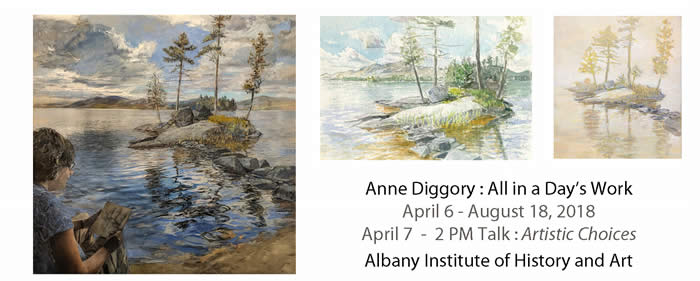
CHOICES AND PROCESS
THE FORMATTING ON THIS PAGE DOESN'T SEEM TO BE TRANSLATING TO IPAD, ETC. SO STAY TUNED
The exhibition at the Albany Institute of History and Art, “Anne Diggory : All in a Day’s Work,” offers viewers a chance to explore my process -- intense concentration on a motif that often yields several works from a single day on location. This brochure documents that process through photographs of the motifs, images of the works in progress and comments about artistic choices. Some choices are intuitive, based on over forty five years of painting, while others are deliberate as I pause to reconsider composition, palette, brush strokes, amount of detail and the visual pathways through the works. As the work develops on paper or canvas the artwork often goes in a direction I hadn’t anticipated, which is part of the adventure of making art.
 Crane Point Series
Crane Point Series
A series of artworks based on the view from privately-owned Crane Point on Blue Mountain Lake began with three paintings created within 24 hours. In the late afternoon of September 15, 2018, I painted a watercolor of the small island just offshore, beckoning as a visual retreat. I was intrigued by the large boulder perched at a tilt.
I chose to sit where the bridge of stepping stones led directly from my perch toward the island. I sketched in the basic shapes, with the island filling the space. The first washes established the cloud pattern and a few defining colors. I simplified some of the details of the island so that its shape would be clearer – leaving out the fallen tree on the left back side, and leaving out one small tree on the right.


First washes of watercolor Crane Point 1, watercolor 7.5x10.5” 2018
I hadn’t planned to return to paint at the same spot, but early the next morning the fog beautifully obscured all except the island. I sat further left on the shore so that the reflections were more visible and the stepping stones were off to the side, making the island accessible visually through the water. I painted grey washes over the warm underpainting and then added a few other details.

 First stage
First stage

I continued to paint the foggy scene after the temporary fog quickly lifted.
Photo by Rebekkah Ziel

Crane Point 2, 10x8”, acrylic on panel 2018
I left for a few hours to take down my nearby exhibition and returned for the mid-day light. I chose to include more of the warmth of the beach at my feet and the beginning of fall colors in the distance. I started on a panel that was tinged with orange.


First brushstrokes. Crane Point 3, 10x10“, acrylic on panel, 2018
In December, about three months after my initial three works at Crane Point, I decided to try a larger version (24x24”), with a different approach to the sky and reflections. I had strong memories and photographs of a time when the sky opened up in the middle, changing the whole experience of the space. I started on a warm ground and slowly added detail, being sure to keep many sections barely suggested. With deeper space suggested I was able to decrease the 2-dimensional height of the mountains and still have them feel “right.”
Left: first day’s work. Right: near completion.


 When I left the site on Crane Point back in September, the sky and water had been darkening and the dramatic light was intriguing. To try that option, in early January 2019 I created two different Photoshop files that combined various painted and photographic versions of the scene. They were printed on canvas so that I could transform them with paint.
When I left the site on Crane Point back in September, the sky and water had been darkening and the dramatic light was intriguing. To try that option, in early January 2019 I created two different Photoshop files that combined various painted and photographic versions of the scene. They were printed on canvas so that I could transform them with paint.


For Crane Point 5, in Photoshop I added two sections of photos to a base layer of an early version of Crane Point 4 (the white areas were transparent).
The base layer for photoshop file for Crane Point 5



Crane Pt 5 As printed on canvas, before painting Crane Pt 5 as completed 24x24”
For the underlying digital print for Crane Point 6 (on right), I added photos of myself and dramatic swirled reflections to a base layer of the file for Crane Point 5.
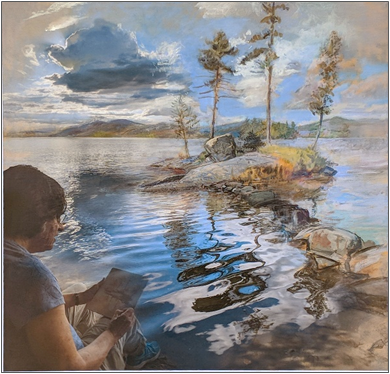

On left, as it was printed on canvas, before painting The final image (right) has major changes to the water in order to integrate the figure and energize surface. The sky was adjusted as well.
 Shoreline Retrospection II (46.5 x 37.5”, hybrid on canvas 2015) uses several layers of detail and interrupted imagery to convey my disorienting experience on October 17, 2007, standing on the shore of Lake George’s Homer Point. I was looking far across the lake at the islands and topography that inspired John Frederick Kensett’s Lake George, 1869, in the Metropolitan Museum of Art, while also fixating on the swirls of color and shapes in the water and rocks at my feet. I spent many years contemplating that contrast of artistic visions before creating this hybrid work. My ongoing research into the painting locations used by John Frederick Kensett in the mid-19th century, and in particular this Homer Point view, made me see the lake through his eyes as well as my own. And only after the publication of part of that research, in the Metropolitan Museum Journal in December 2013, did I finally create a piece that includes both ways of seeing the view, in his day and mine.
Shoreline Retrospection II (46.5 x 37.5”, hybrid on canvas 2015) uses several layers of detail and interrupted imagery to convey my disorienting experience on October 17, 2007, standing on the shore of Lake George’s Homer Point. I was looking far across the lake at the islands and topography that inspired John Frederick Kensett’s Lake George, 1869, in the Metropolitan Museum of Art, while also fixating on the swirls of color and shapes in the water and rocks at my feet. I spent many years contemplating that contrast of artistic visions before creating this hybrid work. My ongoing research into the painting locations used by John Frederick Kensett in the mid-19th century, and in particular this Homer Point view, made me see the lake through his eyes as well as my own. And only after the publication of part of that research, in the Metropolitan Museum Journal in December 2013, did I finally create a piece that includes both ways of seeing the view, in his day and mine.
John Frederick Kensett, Lake George 1869, 44 1/8 x 66 3/8”, The Metropolitan Museum of Art
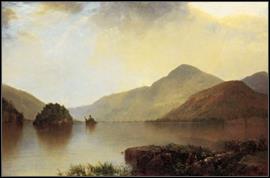

On location I took many photographs
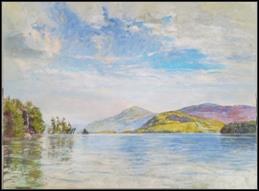 I painted a segment of the distant view Autumn Morning- Homer Point 18x24”, acrylic on panel, 2007, private collection
I painted a segment of the distant view Autumn Morning- Homer Point 18x24”, acrylic on panel, 2007, private collection
I created a digital collage of the Kensett painting, my painting and the on-site photographs before doing more painting. First, I did a midsize version and then reworked the files to do this larger one. Seen in the far distance is a partial image of the Metropolitan’s Kensett painting, which replaces the center of an image of one of my on-site paintings whose brighter colors intrude on the image of the Kensett.
Recluse Island Series.
A set of four works is the result of a paddle to Recluse Island, Lake George, on August 23, 2011, to sketch the same perspective that John Frederick Kensett had sketched on August 23, 1853. I had already determined that he had paid close attention to the topography but had raised the foreground dramatically.
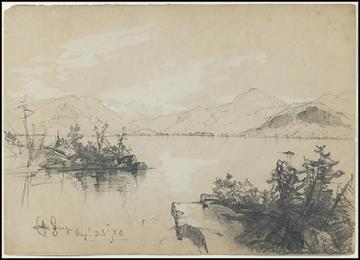
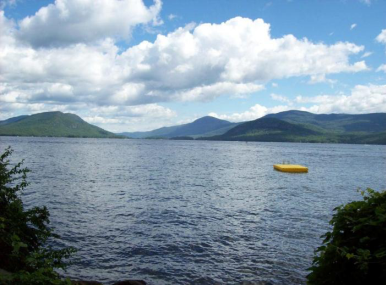
John Frederick Kensett, Lake George,
10x14”, pencil and white on buff paper
1853, private collection
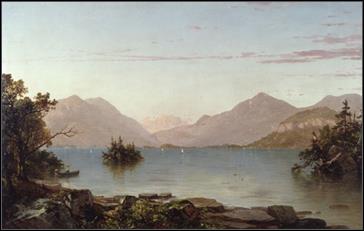
His sketch and several other studies became the basis for his painting Lake George, 1856. Oil on canvas, 26 x 42 in. The Adirondack Experience, Blue Mountain Lake, N.Y. (65.79.1 [112])
First, I worked on two large drawings: Kensett’s View I & II, 15.75x 19.75”
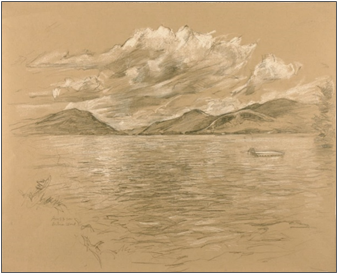
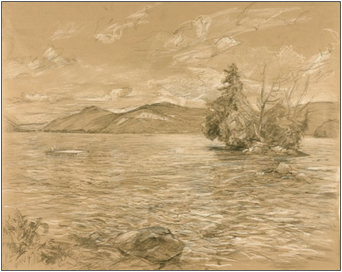
My drawings added drama in the sky and in the wave patterns in the broad expanse of water.
Before paddling back to Bolton Landing, I switched to paint in color to capture the dramatic light at the end of the day.
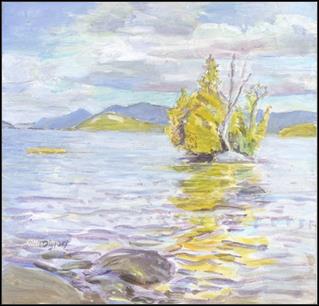
Offshore – Little Recluse, 10x10”, acrylic on panel 2011
Four years after my intensive day on Recluse Island I used Photoshop to create a digital collage that included of a piece of Kensett’s drawing, details from two of my drawings and photographs from that day. The file was printed on canvas and I continued to paint and draw on the surface to create the final piece. The scattered disparate elements and hints of interior framing edges call attention to the mixture of artistic visions, all anchored by the yellow float.
Float, 30x46”, hybrid on canvas, 2015
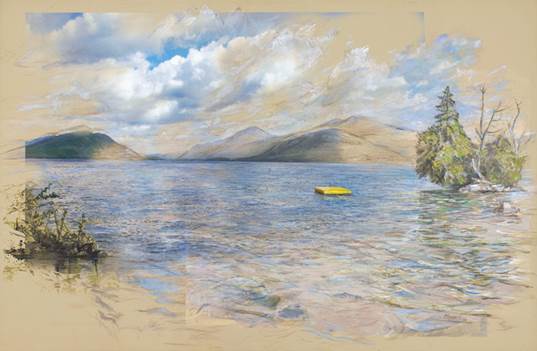
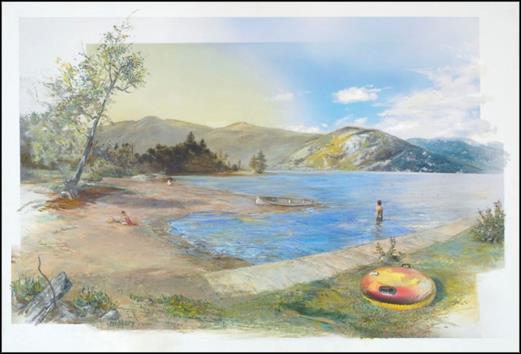 Out of Place in Huletts Landing, (hybrid on canvas, 21x31”, 2018) incorporates shifts in media and framing to express the dynamic visual experience I had at the location on Lake George
Out of Place in Huletts Landing, (hybrid on canvas, 21x31”, 2018) incorporates shifts in media and framing to express the dynamic visual experience I had at the location on Lake George
This artwork is part of a series that combines images of 19th century landscape paintings with my own experience of the same location. When I see the actual landscape that inspired earlier artists, I sense both past and present along with the old and new conventions that filter an artist’s perceptions and approach.
I have been researching historic painting locations of 19th century painters of Lake George since I was asked to give a talk at the Hyde Collection in 2005 about artistic choices in the exhibition “Painting Lake George 1774-1900.” In researching the location of the painting on the left, David Johnson’s Study of Nature, Dresden, Lake George 1870 (Albany Institute of History and Art), I explored the shore of Huletts Landing, where the water level is now much higher. While vegetation has changed, there is still a beach and the distant shoreline matches the details of his painting. Johnson created a second version of the scene in 1874 (below right) with the view partially blocked by tall trees, View of Dresden, Lake George (14.5x24.3” oil on canvas, 1874, private collection).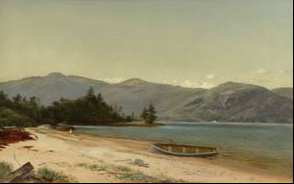
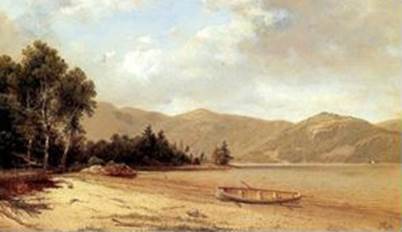
The scene as I saw it in 2005 had a very contemporary colorful float on the shore. In 2015, when I revisited the site prior to giving a talk to the Huletts Landing Historical Society, I became interested in creating my own version incorporating that element as a contrast to the historical view. While I started playing with the combination of images that year, I didn’t start work on a small study until early 2017 and I started this larger version in fall of 2017.
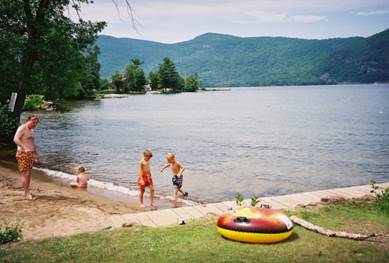
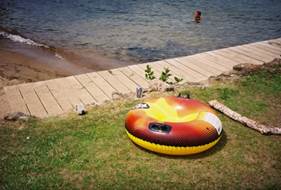
I created a digital file that combined some of my photographs with Johnson’s interpretation. Once the digital collage was printed on canvas, I spent time off and on over the next two months adjusting the colors, details and transitions mainly in the foreground. I wanted the tube to feel both alien and a likely part of the scene, so I worked on introducing warmer tones and emphasized the circular sweep of the shore.
In the final work, the distant shore starts with his version on the left, transitions first to my painted interpretation of Deer Leap and then to a photographic version that has been slightly altered with digital manipulation and some later painting. I invented a curving shoreline to represent both old and new lake levels. I brought Johnson’s left foreground framing device of the dead tree down to my much lower field of vision. I introduced two isolated figures, the young man in the water looking back in space and time and the girl on the beach, ignoring it all and digging in the sand.
------------------
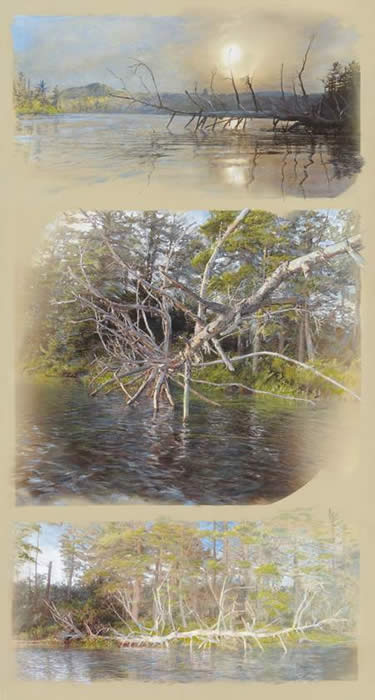 “Branching Out”, 58x31”, hybrid on canvas, 2016
“Branching Out”, 58x31”, hybrid on canvas, 2016
This triptych within one canvas was inspired by a relatively short encounter with a fallen tree as I paddled and sketched by myself on the Bog River near the entrance to Hitchens Pond. The tree had escaped the forest for a new kind of dance on the water, with arms gesturing, freed from the weight of the greenery. To convey the entire experience of that late afternoon I combined the views of first seeing it resting in the fading light (at top), spinning toward me as I paddled by (middle) and then dramatically lit and stretched out against the forest as I looked back (bottom). To emphasize the passage of time I used rhythms of color and shape along with combinations of sharp and blurry details to pull the eye around and between the separate images.
On a visit to the location after the work was finished: 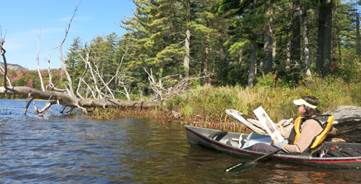
Saranac Lake Series
Saranac Lake Series
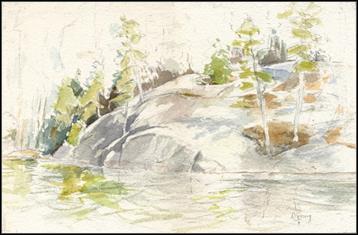 Three paintings of a large rock formation on the back of Bluff Island in Lower Saranac Lake were inspired by a canoe trip September 29th, 2016. From my canoe I painted a watercolor to capture the major shapes and relationships.
Three paintings of a large rock formation on the back of Bluff Island in Lower Saranac Lake were inspired by a canoe trip September 29th, 2016. From my canoe I painted a watercolor to capture the major shapes and relationships.
Study for Rock Flow, 8.5 x 13.125”, watercolor, 2016
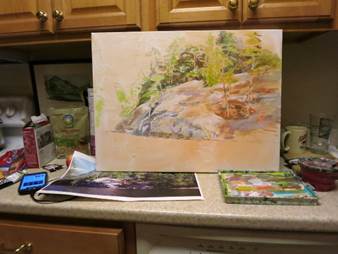 The night before returning to the island 6 days later to paint a larger version, I laid out the basic composition, using my watercolor and photographs.
The night before returning to the island 6 days later to paint a larger version, I laid out the basic composition, using my watercolor and photographs.
I then paddled to Partridge Island to set up on shore just behind where I had painted the watercolor from my canoe.
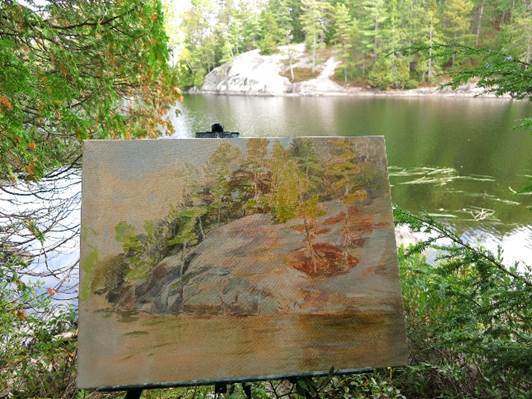
The stages of painting “Rock Flow”
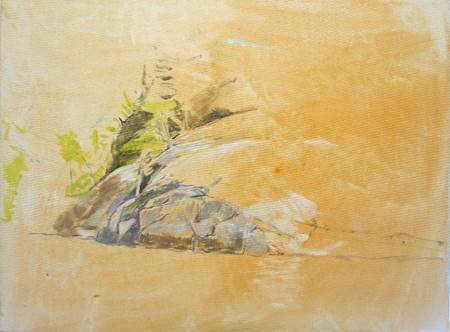
Over a toned canvas, establishing water line and placement of the curve of rock that will dominate the painting.
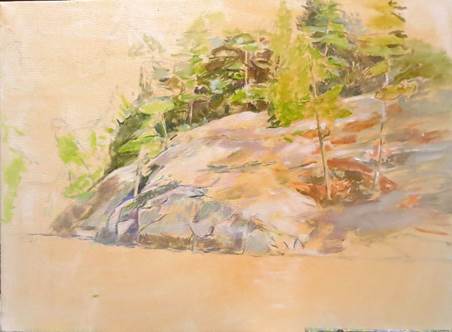
Establishing shadows and the rest of the rock slope. Finding shapes and color shifts that will establish the volume and light.
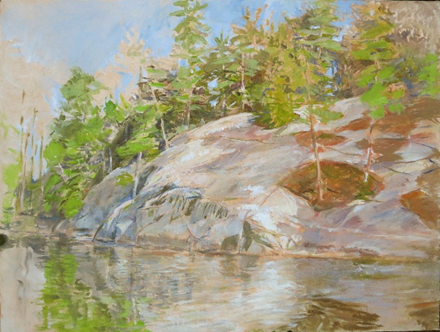 Beginning work on reflections. Adding sky. More carefully differentiating both greys and greens.
Beginning work on reflections. Adding sky. More carefully differentiating both greys and greens.
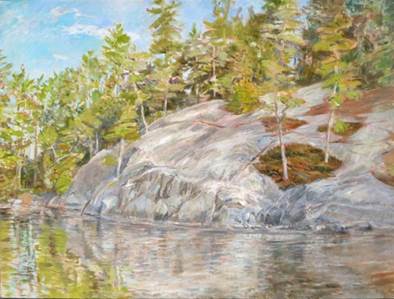
Adding detail to reflections, adjusting shapes
overall.
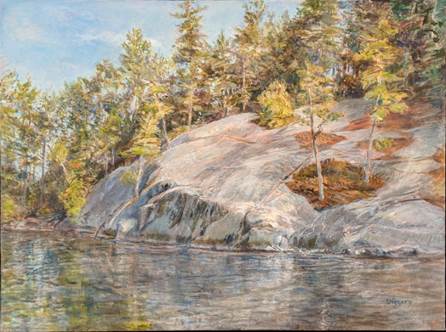
Adjustments to the reflections create a stronger plane and also put the emphasis back on the larger shapes of the rock flow.
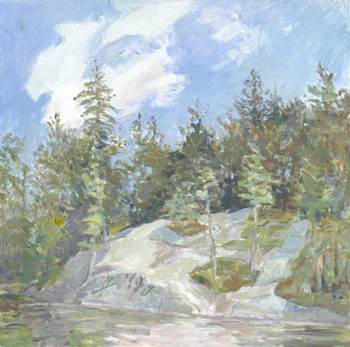 Eight months after the initial watercolor, I returned with the nearly complete Rock Flow, planning to make further adjustments. But when I got there, I decided to paint a new version inspired by the way that the passing clouds were in dialogue with the shapes of the rock formation.
Eight months after the initial watercolor, I returned with the nearly complete Rock Flow, planning to make further adjustments. But when I got there, I decided to paint a new version inspired by the way that the passing clouds were in dialogue with the shapes of the rock formation.
Someday I may finally get to another idea I have, of an artwork that includes the painting on the easel, the view and some people on the far shore.
Passing Swirl, 10x10” acrylic on panel, 2017
For more information on the hybrid approach that combines photography and painting go to http:hybridvisions.diggory.com
Contact the artist for information about prices.
To Contact Anne or be added to her email alerts, click here and scroll down
Online catalogue of hybrid work is at http:hybridvisions.diggory.com
Online catalogue of Saratoga Treescapes: Saratogatrees.diggory.com
Inventory of work up to 2002 www.diggory.com/cd
©All Rights Reserved Anne Diggory 2014